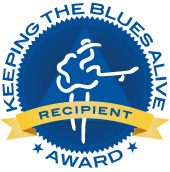 Mojo Hand
Mojo Hand
The Life and Music of Lightnin’ Hopkins
Timothy J. O’Brien & David Ensminger
University of Texas Press
241 pages plus photos & notes
One of the truly iconic figures in the history of blues music, Sam “Lightnin’ Hopkins made his mark as a guitarist, singer and songwriter. His music never strayed far from his roots in the rural Texas countryside where he grew up or the welcoming comfort of the tight-knit Third Ward community in Houston where he lived for much of his adult life.
The book grew out of author Timothy O’Brien’s fascination for Hopkins, an attraction so strong that the author wrote his dissertation on the bluesman. He spent years researching; digging deep to find hidden-away details that had gone unnoticed with the passage of time. Co-author David Ensminger became involved in the project when O’Brien discovered that he had cancer in 2009. In the book’s Foreword, Ensminger writes “O’Brien was compelled, seemingly deep in his DNA, to capture Hopkins often raw-boned, sizzling, and incantatory oeuvre.” A social activist who worked in support of worker’s rights and against the death penalty in Texas, as well as being a huge fan of music from many genres, O’Brien writes from a viewpoint that understands the social issues of the times and their impact on Hopkins as a human being as reflected in his music.
The books traces Hopkins’s life from the early days in Centerville, located in between Dallas and Houston. While his birthdate of March 15 has never been in question, the year of his birth has never been pinned down. O’Brien’s research left him convinced that 1912 was correct, siting Hopkins using that year on his Social Security account.
His father, Abe, was a sharecropper and the family faced a hard-scrabble lifestyle that was common in the rural south. Abe was murdered when Lightnin’ was just three years old. His mother, Frances, struggled to care for her five children. Before his oldest brother left home, Hopkins would “borrow” his guitar and began to develop his trademark style. Other local musicians helped keep the musical flames burning in the young man’s heart. The lynching of a local African-American male served warning to the young man to keep his place, a point Hopkins never forgot in dealings outside of family and friends.
There isn’t much accurate information about Lightnin’s existence from the early 1920’s until he made his move to Houston in twenty years later. There is no doubt that Hopkins picked cotton in addition to sharpening his skills on guitar by playing local dances and jook joints. He also told of spending time on a chain gang but O’Brien could not find any collaborating evidence in official records. Houston had tremendous club scene that meant any musician worth his salt could find plenty of work.
To be able to be heard in the noisy night spots, Hopkins switched to electric guitar. He had some regional hits before recording twenty-eight tunes for Herald Records. Released in 1954, Hopkins, backed by a three piece combo, was on fire. These tracks had a huge influence at the time and continued to reverberate through the years. The smoking instrumental track “Hopkins Sky Hop” would later provide the framework for the well-known Stevie Ray Vaughan guitar workout, “Rude Mood”.
O’Brien covers the impact of the folk and blues revival in the 60’s on Hopkins career as well as discussing at length the musician’s distrust of contracts, preferring to be paid for recording up front by the song or the session. While he signed contracts with record labels during his career, Hopkins was always ready to cut another record if someone was ready with the cash. While the revival opened up opportunities to play all over the world, Hopkins was none too comfortable traveling for very long. His first trip to Europe in 1964 left him shaken and bed-ridden with a mysterious ailment for a week after a thirteen hour plane ride. He preferred to hang out with his friends in the Third Ward, where he was treated as a star until his death in 1982.
The biography maintains a focus centered on Lightnin’ and his music. Personal details like his long-standing relationship with Antoinette Charles, married to another man, are mentioned but not delved on in depth. O’Brien uses quotes from musicians like Dave Alvin, Peter Case, Billy Gibbons, and Dion DiMucci to illustrate the impact of Hopkins music over time. He has crafted a fascinating, well-researched look at a true blues legend, and helps us understand the social environment that created such powerful music.
Reviewed by Mark Thompson







No comments:
Post a Comment